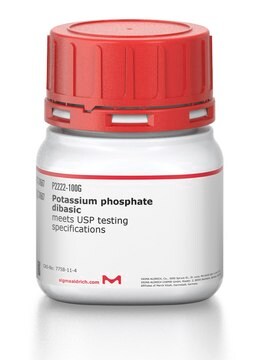60349-M
Potassium phosphate dibasic trihydrate
puriss. p.a., ≥99.0% (T)
Synonym(s):
Dipotassium hydrogen phosphate trihydrate, Dipotassium phosphate, di-Potassium hydrogen phosphate trihydrate
About This Item
Recommended Products
grade
puriss. p.a.
Quality Level
Assay
≥99.0% (T)
form
crystalline powder
impurities
≤0.001% total nitrogen (N)
pH
9.1-9.4 (25 °C, 50 mg/mL in H2O)
anion traces
chloride (Cl-): ≤20 mg/kg
sulfate (SO42-): ≤50 mg/kg
cation traces
As: ≤0.1 mg/kg
Ca: ≤10 mg/kg
Cd: ≤5 mg/kg
Co: ≤5 mg/kg
Cr: ≤5 mg/kg
Cu: ≤5 mg/kg
Fe: ≤5 mg/kg
Mg: ≤5 mg/kg
Mn: ≤5 mg/kg
Na: ≤500 mg/kg
Ni: ≤5 mg/kg
Pb: ≤5 mg/kg
Zn: ≤5 mg/kg
SMILES string
O.O.O.[K+].[K+].OP([O-])([O-])=O
InChI
1S/2K.H3O4P.3H2O/c;;1-5(2,3)4;;;/h;;(H3,1,2,3,4);3*1H2/q2*+1;;;;/p-2
InChI key
XQGPKZUNMMFTAL-UHFFFAOYSA-L
Looking for similar products? Visit Product Comparison Guide
General description
Storage Class Code
11 - Combustible Solids
WGK
WGK 1
Flash Point(F)
Not applicable
Flash Point(C)
Not applicable
Choose from one of the most recent versions:
Already Own This Product?
Find documentation for the products that you have recently purchased in the Document Library.
Our team of scientists has experience in all areas of research including Life Science, Material Science, Chemical Synthesis, Chromatography, Analytical and many others.
Contact Technical Service



